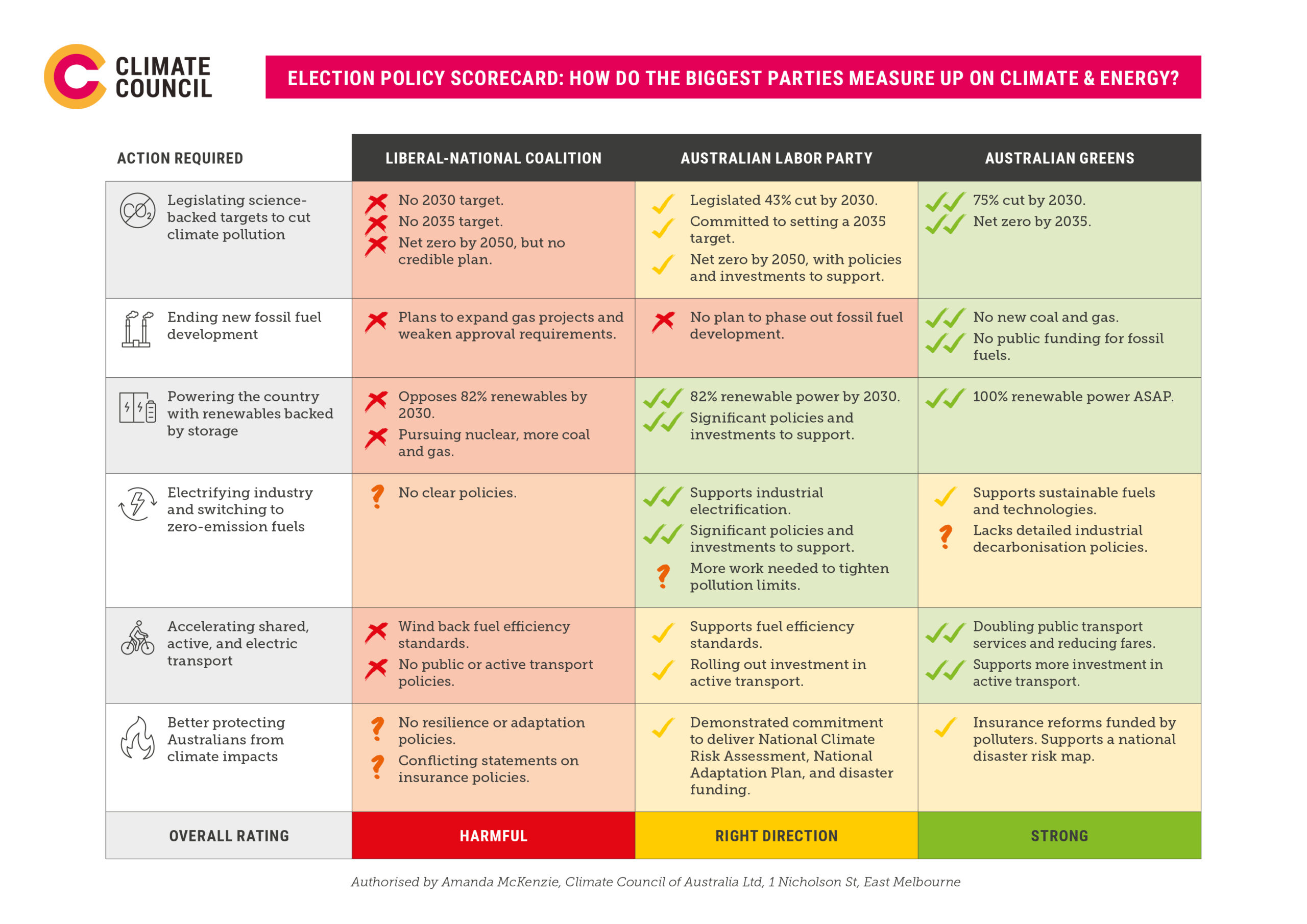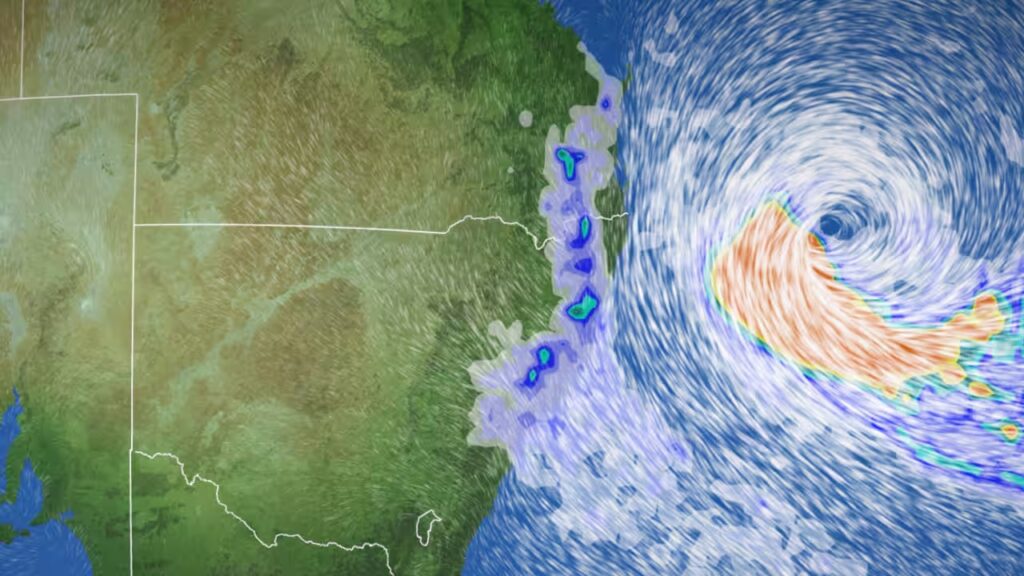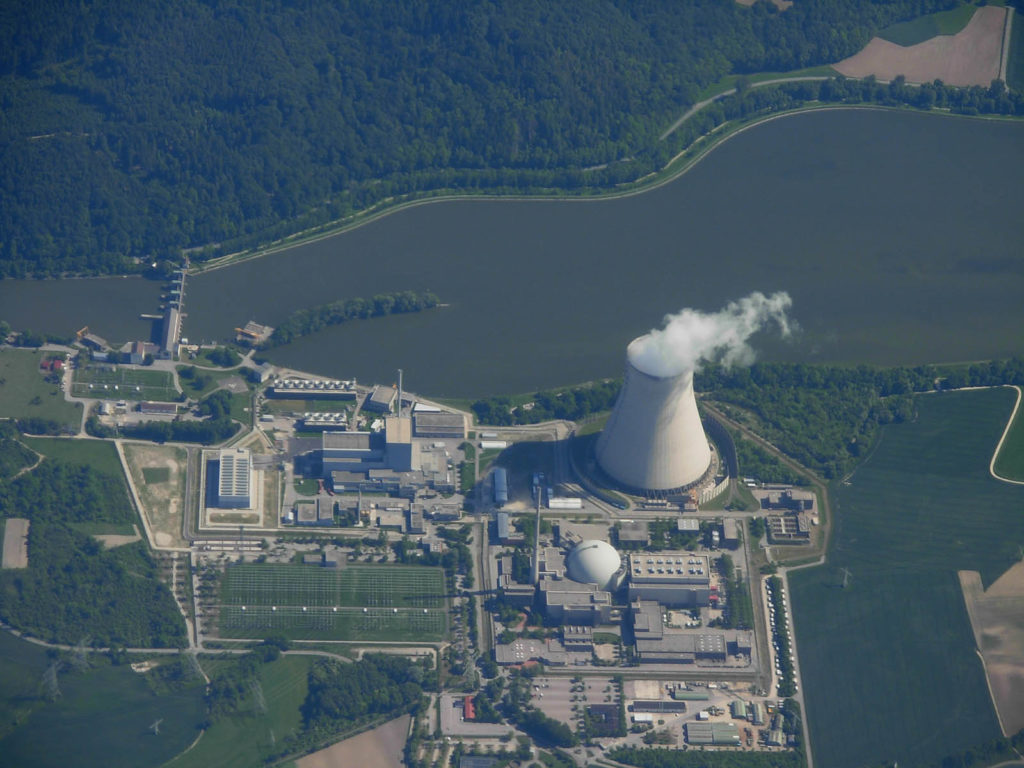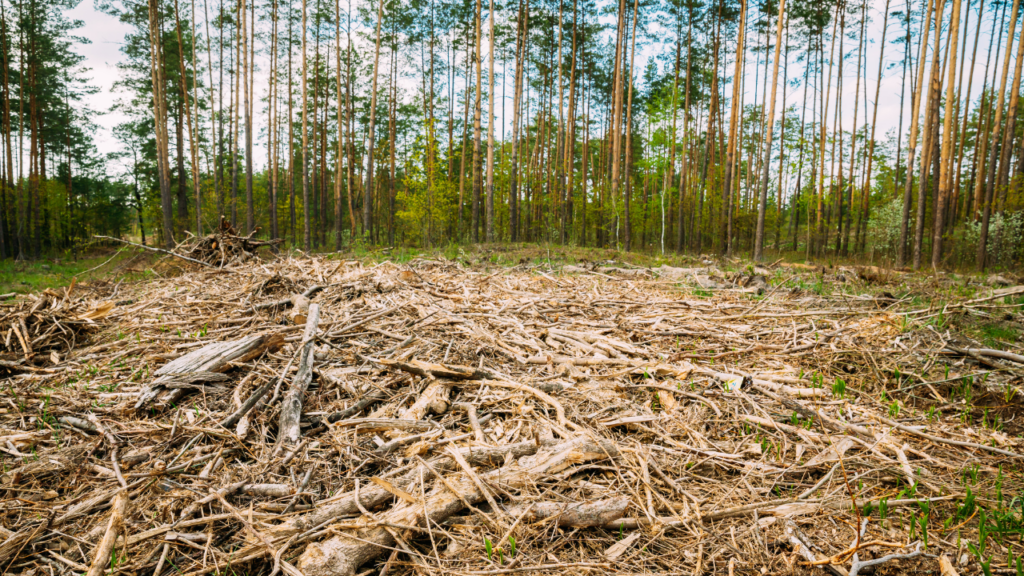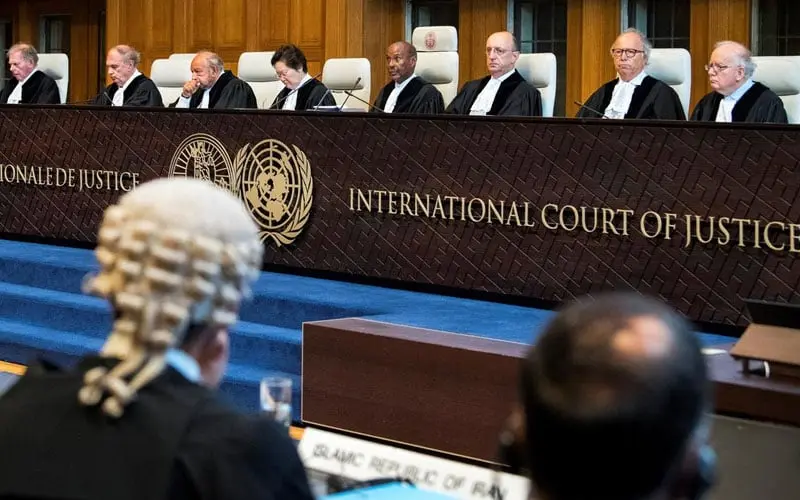Curious as to where the three largest political parties in Australia stand on climate and energy policy? Look no further!
The federal election is around the corner, and it’s clear the next term of the Australian Parliament will be critical for climate action. Our next government must build on the progress made over the last three years, and go further and faster to cut climate pollution and protect Australian communities from the ravages of escalating climate disasters.
We’ve summarised the climate and energy policies of the Australian Labor Party, the Liberal National Party, and the Australian Greens so you can vote in the 2025 federal election armed with the facts.
The Climate Council has considered each party’s policies, public comments and statements, and recent parliamentary records to build a full picture of how each party may seek to maintain, advance, or regress climate and energy policy in the 48th Parliament.
So, will Australia’s next government keep up the momentum behind real, tried and tested solutions, or will it divert from the critical path and pursue solutions that are too slow or that send us backward?
This analysis is current as of 31 March, 2025.
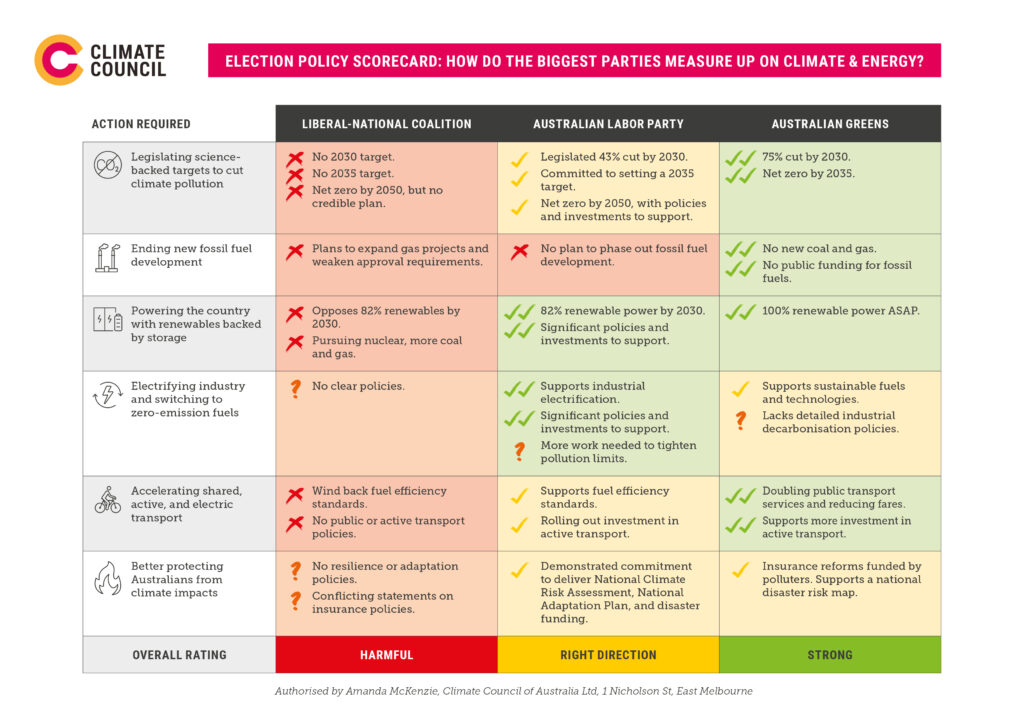
Click on the dropdowns below to reveal more detail about each of the parties and how we have rated their climate and energy policies.
The Australian Labor Party
A future Labor Government would keep building on climate progress, but the party’s position on fossil fuels threatens to undermine this momentum.
The Albanese Labor Government has strengthened Australia’s climate policy in this last term, cutting expected 2030 emissions by 39 million tonnes and establishing a clear legal and policy framework to guide Australia’s response to climate change.
Labor has committed to building on its climate policies if re-elected, focusing on delivering existing targets and programs to back-in renewable power, storage, and the clean industries of the future. It also has a clear plan to continue cutting climate pollution this decade and double renewable energy, backed by storage, by 2030.
However, stronger action is needed from Labor to end new and expanded fossil fuel developments to ensure progress in sectors like electricity, industry, and transport is not undermined. A clear plan to phase out fossil fuel expansion would solidify Australia’s path toward deep emissions cuts and a cleaner future, and until Labor develops such a plan, genuine progress to cut climate pollution to the levels required will continue to be undermined.
Legislating science-backed targets to cut climate pollution
➡️ Right direction: Labor are committed to reducing climate pollution by 43% on 2005 levels by 2030, and have legislated mechanisms for both annual reporting and ongoing climate science advice. They have not indicated any intention to strengthen the 2030 target and have not yet committed to a 2035 target, although they have indicated that they will consider the advice of the independent Climate Change Authority in setting a 2035 target, as is currently required by law.
Ending new fossil fuel development
❌ Harmful: Labor has committed to strengthening Australia’s environmental laws but has yet to ensure they account for climate change, the greatest threat to our natural environment. In its first term, Labor failed to pass legislation on this issue, and also approved 12 new and expanded coal mines and five new and expanded gas projects. It also passed the ‘Sea Dumping Bill,’ supporting new fossil fuel projects by enabling offshore carbon capture and storage. While policies like the Safeguard Mechanism aim to cut pollution, a clear plan to phase out new or expanded fossil fuel developments is needed to align with Australia’s climate goals.
Powering our country with renewable power backed by storage
✅ Strong: In government, Labor has adopted a non-binding target of 82% renewable electricity by 2030, and has implemented several significant policies to support this – namely the Capacity Investment Scheme and Rewiring Australia. Labor is expected to maintain this target, and set new ambitions for the 2030s. Labor will also reportedly introduce new support for household batteries, consistent with its ambition to reach a high share of renewable power by 2030.
Electrifying industry and switching to zero-emission fuels
✅ Strong: Labor has supported cuts to climate pollution from industry through the reformed Safeguard Mechanism. However, the mechanism is still too reliant on carbon offsets, and its coverage is too narrow. More ambition is needed across all these areas to get us on track for the necessary cuts to climate pollution. The mechanism is due for review in 2026-27, offering a key opportunity to fix and strengthen these important regulations. Labor has also set up clear policies and incentives to encourage the development of new clean industries, including the production of green metals, critical minerals, green hydrogen, green ammonia, and low carbon liquid fuels through its Future Made in Australia plan.
Accelerating our move to shared, active and electric transport
➡️ Right direction: Labor has announced $1 billion to secure a rail corridor in Western Sydney and $2 billion for the upgrade of Melbourne’s Sunshine Station, which could see better shared transport access for local residents. Further policies to cut climate pollution from transport during a potential second term have not yet been announced, but Labor is expected to continue to deliver its commitments from the 47th Parliament.
In this term of government, Labor took initial steps to expand shared and active transport, including establishing the $100m active transport fund, which aims to increase walking and cycling through the upgrade of existing and construction of new bicycle and walking pathways.
Labor also implemented the New Vehicle Efficiency Standard (NVES), which will give Australians access to cleaner new cars, including more electric vehicles, and they have committed to retain this. Labor also developed Australia’s first National Electric Vehicle Strategy, and commenced consultation on development of a Transport and Infrastructure Net Zero Roadmap and Action Plan,12 both of which they have indicated they would deliver if re-elected.
Better protecting Australians from the impacts of climate change
➡️ Right direction: Labor has not yet announced further resilience and adaptation policies for a potential second term, but is expected to continue to deliver its commitments from the 47th parliament.
In this term of government, Labor introduced the Hazards Insurance Partnership to improve insurance affordability and availability, and reviewed the Australian Climate Service, national natural disaster governance arrangements and Commonwealth disaster funding.
Labor also committed $27.4 million toward the development of a National Climate Risk Assessment and National Adaptation Plan, and $200 million per year toward disaster preparedness and resilience. However, neither the Risk Assessment or Adaptation Plan have been delivered within this parliamentary term. With the previous strategy expiring in 2025, Australia effectively has no national risk assessment or adaptation strategy. These strategies must be delivered as a priority by any future government, but Labor has not yet committed to a timeline for their release.
Labor has committed to building on its climate policies if re-elected.
The Liberal National Party
The Liberal-National Coalition has no credible plan to cut climate pollution and their nuclear scheme could increase climate pollution by 2 billion tonnes.
When the Climate Council reviewed the last Coalition Government, in power from 2013 to 2022, we found “a complete and catastrophic failure to act on the climate crisis”. The Federal Coalition’s voting record and policies announced in opposition over the past three years suggest little has changed.
The Liberal-National Coalition’s climate and energy policies would be actively harmful, taking Australia backwards from our current trajectory. The Liberal-National Coalition’s plan to slow the renewables rollout and pursue nuclear reactors would alone lead to at least 2 billion tonnes more climate pollution. Promises to expand gas production by the “bucket load” and wind back Australia’s 2030 emissions reduction target would see climate pollution increase even further.
Amongst the three largest parties in the 47th parliament, and based on their current policies and voting record, the Climate Council has ranked the Liberal-National Coalition worst on climate change.
Legislating science-backed targets to cut climate pollution
❌ Harmful: The Coalition claims to be supportive of net zero climate pollution by 2050, yet many of its members continue to oppose this target. In September 2023, the National Party debated retracting its net zero commitment, and in January 2025, Nationals Senator Matt Canavan publicly declared “No more net zero!”
The Coalition has confirmed that it would abandon the current climate pollution reduction target of 43% on 2005 levels if elected, despite this target already being legislated, and has refused to commit to a different 2030 target unless it is elected. Independent expert analysis indicates that the Coalition’s current nuclear policy implies a maximum emissions reduction of 38% on 2005 levels by 2030 – significantly weaker than Australia’s current target.
Public commentary from the Coalition has also raised questions regarding whether the Party intends to commit to medium term targets if elected, with one high-profile Liberal indicating in February 2025 that they may not set a 2035 emissions target. Subsequent media reports highlighted clear disparities with the Liberal and National party room on the issue.
Concerningly, the Coalition has also intensified attacks on independent science agencies and authorities:
- Opposition Leader Peter Dutton has repeatedly made unevidenced claims that the CSIRO is politically compromised, claiming in December 2024 that their in-depth work on nuclear costings had been politically influenced.
- In February 2025, senior members of the Coalition publicly threatened to sack the chair of the Climate Change Authority, an independent organisation responsible for informing Australia’s climate policy with science-backed advice.
- The Coalition’s energy spokesperson Ted O’Brien further claimed that the Authority’s independent analysis of the Coalition’s nuclear policy demonstrated that the Authority had become a “puppet” – despite their analysis being entirely based on data from the Coalition’s own modelling.
Ending new fossil fuel development
❌ Harmful: The Coalition’s 2025 election platform includes cutting approval requirements for new gas projects, encouraging increased exploration and development, such as the highly-polluting Beetaloo Basin gas reserve. They have committed to spending $1.3 billion to expand extraction of polluting gas and build new pipelines, despite Australia’s gas needs dwindling.
The Coalition has committed to “bring[ing] on more gas by the bucket load” and has publicly supported the recent approval of polluting coal and gas projects. The Coalition has also stated it would approve the highly polluting North West Shelf project, despite the proponent’s own analysis showing the project would lead to 90 million tonnes of climate pollution each year, equivalent to over one-fifth of Australia’s yearly emissions.
Powering our country with renewable power backed by storage
❌ Harmful: The Coalition has outwardly opposed renewable energy, and would not achieve Australia’s current target of 82% renewable electricity by 2030.
Instead, the Coalition has committed to pursuing taxpayer funded nuclear reactors, despite experts confirming they would take too long to build, increase power bills for Australians, and be at risk of significant budget and timeline blowouts. They would also provide government support for gas generation, encouraging more polluting electricity. At the same time, they have committed to cutting $20 billion in support for essential transmission projects if elected.
The Coalition’s own modelling shows that its nuclear scheme would result in one billion tonnes more direct climate pollution by 2050 than Australia’s current plans, with the potential for at least a billion tonnes of additional climate pollution from transport and industry caused by slowing the transition to renewables. Pursuing nuclear would delay action to cut climate pollution from electricity for at least a decade, with climate pollution remaining higher than under our existing plan for more than 20 years.
The Coalition has also made misleading claims about the cost of their plan, including claiming that the total cost of nuclear would be lower than Australia’s current plan, while significantly underestimating the costs of building and operating nuclear reactors, including by planning to produce far less power than Australia is expected to need. Opposition Leader Peter Dutton has also claimed that their modelling shows that nuclear would reduce household bills, despite it explicitly stating that “electricity prices are not modelled in this project”. Coalition members themselves have undermined their colleagues’ claims on the cost of nuclear, with Coalition Senator Matt Canavan stating nuclear “ain’t the cheapest” form of energy.
The Coalition has suggested it may introduce policies to support household batteries, despite Opposition Leader Peter Dutton previously questioning the effectiveness of batteries, saying in 2024 “Hopefully the battery technology [needed to provide consistent energy] is about to be discovered, but not yet.”
The Coalition has also committed to blocking important updates to the National Construction Code,, including proposals to ensure all new commercial buildings install rooftop solar.
Electrifying industry and switching to zero-emission fuels
❓No plan: During this term of Parliament the Coaltion opposed reforms to the Safeguard Mechanism, which requires Australia’s biggest polluters to cut their climate pollution. The Coalition is reportedly planning to weaken or abolish the mechanism if elected. They also opposed legislation enabling the Future Made in Australia plan, which supports the growth of new clean energy industries. The Coalition has committed to cutting support for green hydrogen under the plan, which is essential to cut climate pollution from steel production and other heavy industries.
The Coalition has not committed to any policies to cut climate pollution from industry. The Coalition has also not committed to any policies that support the development of green hydrogen, ammonia, or sustainable aviation fuel.
Accelerating our move to shared, active and electric transport
❌ Harmful: During this term of parliament, the Coalition expressed clear opposition to and ultimately voted against Labor’s New Vehicle Emission Standards (NVES) – a measure to give Australians access to cheaper and cleaner new cars while cutting climate pollution. During debate over the reforms, opposition leader Peter Dutton consistently repeated the false claim that the standard was a ”‘car and ute tax”. Other Coalition MPs have continued to repeat this claim.
In March 2024, Opposition Leader Peter Dutton stated that the Coalition would not support Labor’s fuel efficiency standards, regardless of any concessions made, and in October 2024, criticized the NVES legislation, labeling it poorly considered and problematic. The Coalition will reportedly abolish or weaken the standards if elected.
The Coalition currently has no policies to expand access to shared and active transport.
Better protecting Australians from the impacts of climate change
❓No plan: The Coalition has not announced any policies to protect Australians from the impacts of climate change.
In February 2025, Opposition Leader Peter Dutton criticised major insurers for high premiums in disaster-hit areas like North Queensland, suggesting a Coalition government may break up insurers found to be overcharging. However, no details have been released regarding how this policy would work in practice, or how effective it would be in the absence of broader policies to tackle the underlying causes of these rising premiums and/or a broader range of disaster preparedness and resilience policies. Shadow Treasurer Angus Taylor later contradicted the Opposition Leader, claiming that the Coalition had “been clear” that insurance was excluded from their divestiture policy, leaving the Coalition’s plans uncertain.
The Federal Coalition’s nuclear scheme would be a climate disaster, as it would lock in at least two billion more tonnes of pollution from coal, oil and gas.
The Australian Greens
The Greens support science-aligned action on climate, including an end to new coal and gas.
In this term of parliament the Greens have lifted ambition, slowed the expansion of fossil fuels, and worked to prevent government funding for coal, oil and gas.
The Greens are the only major political party with seats in the current parliament that supports science-aligned targets to reduce climate pollution and an end to new and expanded coal and gas projects. Their actions during the 47th Parliament advanced climate action, pushing the Labor government to go further in exchange for the passage of legislation in the senate, and the Party’s policy platform indicates that Australians should expect more of the same in the next parliamentary term.
Legislating science-backed targets to cut climate pollution
✅ Strong: The Greens have advocated for science-aligned reductions to climate pollution, acknowledging the need to reach net zero by 2035 or sooner. They have previously sought to amend Australia’s climate change laws to incorporate this 2035 net zero target, with an interim target of a 75% reduction on 2005 levels by 2030.
Ending new fossil fuel development
✅ Strong: The Greens have pledged to stop new coal and gas projects, and have already passed a number of amendments making it harder for new gas projects to be developed, including preventing the use of public funds for investment in coal and gas.
Powering our country with renewable power backed by storage
✅ Strong: The Greens support expanding renewable energy, including providing grants and low interest loans for homes and businesses to electrify and install solar and batteries, and building publicly owned renewable energy. Their party policy platform supports “100% of electricity used in Australia to come from renewable sources as soon as possible”.
‘More detail regarding specific policy mechanisms or funding to achieve these ambitions would assist to strengthen the Greens policy platform’.
Electrifying industry and switching to zero-emission fuels
➡️ Right direction: The Greens would end fossil fuel subsidies (i.e. the diesel excise rebate) for industries other than agriculture. In this term of parliament, the Greens supported Labor’s Future Made in Australia plan after securing amendments which prevent it from funding fossil fuel projects.
The Greens do not otherwise have detailed policies to support the growth of clean industries, or cuts to climate pollution from existing industry.
Accelerating our move to shared, active and electric transport
✅ Strong: The Greens would increase funding for shared and active transport, including doubling the number of high-frequency public transport services in major cities by 2030, introducing 50c fares nationally, building Melbourne to Brisbane high speed rail by 2040, and investing in active transport infrastructure.
To ensure a measurable impact on share and active transport uptake, the Greens plan could also incorporate more specific targets for mode shift or public transport access, and assess the cost-effectiveness of policy measures such as 50c fares in increasing shared transport use.
Better protecting Australians from the impacts of climate change
➡️ Right direction: The Greens have announced a policy to improve insurance affordability in disaster-prone regions by expanding the ‘cyclone reinsurance pool’ to all natural disasters, and requiring fossil fuel companies to contribute to the pool, and the Disaster Ready Fund under a ‘polluter pays’ principle. They have also committed to establishing a public national disaster risk map to provide access to better information on the risk posed by climate-fuelled natural disasters. The Australian Greens also introduced a broader Polluter Pays bill, which intends to make big polluters legally liable for the costs of climate disasters.
It is important that these policies also incorporate a broader plan to reduce the nation’s overall risk exposure, including assisting households to move out of high risk areas, and preventing the building of new homes and infrastructure in these areas. While increasing the affordability of insurance is important, it also has the potential to encourage households to settle or remain in high-risk areas, which must be addressed.
The Greens supported and strengthened Australia’s climate reforms, and continue to push for more ambitious climate action.
Independents and the crossbench
A growing, positive force for stronger climate action.
Independents played a critical role in strengthening Australia’s climate laws in this last parliamentary term, and their influence is only expected to grow in the next parliament. With polls suggesting neither major party is likely to form a majority government in 2025, a stronger pro-climate crossbench could positively shape Australia’s next wave of climate policies.
Over the past three years, independents secured real and sensible wins on climate action, such as increasing ambition, transparency and integrity in the Climate Change Act, backing policies for cleaner and cheaper-to-run cars, and advocating for greater household electrification support. Independents also introduced or pushed for amendments to limit new coal and gas projects, strengthen climate pollution reduction targets, and introduce a legal duty of care to protect future generations from climate harm—though these were all blocked by the two major parties.
With the strong possibility of a hung parliament at the upcoming election, members of the crossbench are likely to be in a strong position to negotiate with the major parties, using their influence to secure greater climate action.
A strong, pro-climate crossbench could be a critical pathway to ensuring Australia’s transition to clean energy and climate pollution reductions accelerate in the next term of government.
In the 2025 Federal election, many of the independents and minor parties who contributed to strong climate action in the previous Parliament are running with practical climate policies that go beyond the current commitments of the two major parties.
Every independent candidate is different.
Every independent Member of Parliament and candidate is different and should be assessed based on their individual policies, commitments, and track record. While many independents have championed strong climate policies, not all members of the crossbench prioritise climate action or have a voting record that supports climate action. This list of policies is not intended to be exhaustive, but highlights positive policies from independent MPs and Senators from the 47th Parliament. Voters should carefully review each candidate’s stated policies and positions, from trusted sources, to determine their approach to addressing climate change.
Legislating science-backed targets to cut climate pollution
Many independents are continuing to advocate for stronger climate pollution reduction targets, including Dr Monique Ryan, Allegra Spender, Zali Steggall and Zoe Daniel backing a target of 75% by 2035, while others push for a stronger 2030 target, such as Dr Sophie Scamps.
Ending new fossil fuel development
A significant number of independent candidates recognise the essential need to end new fossil fuel development. Dr Sophie Scamps is advocating for a phase out of coal and gas, while Kylea Tink and Allegra Spender have supported an end to new coal and gas projects. Kate Chaney, supported by Allegra Spender and David Pocock, has called for an end to taxpayer-funded fossil fuel subsidies. Other independents, including Dr Monique Ryan, have called for tougher rules to ensure a “reasonable tax return” from offshore oil and gas producers.
Other independents including Allegra Spender and Kate Chaney have called for reforms to Australia’s broken environment laws, while David Pocock and Sophie Scamps have each introduced bills to require governments to consider the impact of their actions – including as fossil fuel approvals – on future generations.
Powering our country with renewable power backed by storage
Many independents are advocating for practical policies to expand renewable power and storage, while delivering cost of living relief to households. This includes Dr Sophie Scamp’s policy to support Australian families to install a home battery and Zali Stegall’s support for home electrification. Allegra Spender has also proposed support for energy efficient upgrades to homes alongside minimum standards for rental properties, and disclosure of home energy efficiency ratings during sale. Specific to regional communities, Dr Helen Haines has advocated for more micro-grids, which would see regional communities able to power themselves independently during disasters or outages, primarily with renewable power and battery storage.
Electrifying industry and switching to zero-emission fuels
Independents like Zoe Daniel are backing industrial energy efficiency, including greater recycling of steel and aluminium. Proposals to phase out fossil fuel subsidies, backed by independents including Allegra Spender and Kate Chaney, would also provide a clearer incentive for industry to reduce its use of fossil fuels.
Accelerating our move to shared, active and electric transport
Independents are backing the faster rollout of electric vehicles, with independent Zoe Daniel aiming for one-third of road kilometres to be travelled by electric vehicles, backed by electrification of taxis and rideshare vehicles. Independents backed the passage of the NVES in this term of parliament, making it easier for Australians to access a larger range of new electric and low emission vehicles.
Expanding shared and active transport is essential to cutting climate pollution from transport quickly enough. Some independents are calling for better access to shared and active transport options for their communities, including Dr Helen Haines, who is advocating for fast, frequent and reliable trains between Wodonga and Melbourne.
Better protecting Australians from the impacts of climate change
A number of independents are pushing for more action to make Australia more resilient to climate impacts. Independent Zali Stegall is continuing to push for a National Framework for Adaptation, which would comprehensively assess and plan for the impacts of climate change. This would include a legally binding requirement for the government to plan for the impact of climate change, and provide transparent information about climate risks and adaptation planning. Other independents, including Dr Sophie Scamps, have backed long-term adaptation strategies, and committed to advocating for more support for communities experiencing and recovering from extreme weather.
The influence of pro-climate independents is only expected to grow in the next parliament.
Read more in our new report Climate Crossroads: Progress, Politics and a Pivotal Election, where we outline what the science tells us needs to be done in the next term of Parliament, and what credible climate policy looks like across six key priority areas.
Climate Council is non-partisan and advocates for evidence-based policies that will progress science-aligned climate action.
Authorised by Amanda McKenzie, Climate Council of Australia Ltd, 1 Nicholson St, East Melbourne.

